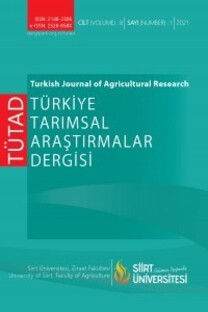Synthesis and Characterization of Veronica beccabunga Green Synthesized Silver Nanoparticles for The Antioxidant and Antimicrobial Activity
Veronica beccabunga, Antimicrobial, Antioxidant, nanoparticle, characterization
Synthesis and Characterization of Veronica beccabunga Green Synthesized Silver Nanoparticles for The Antioxidant and Antimicrobial Activity
Veronica beccabunga, antimicrobial, antioxidant, nanoparticle, characterization,
___
- Aazam, E.S., Zaheer, Z., 2016. Growth of Ag-nanoparticles in an aqueous solution and their antimicrobial activities against Gram-positive, Gram-negative bacterial strains and Candida fungus. Bioprocess and Biosystems Engineering, 39(4): 575-584.
- Blois, M.S., 1958. Antioxidant determinations by the use of a stable free radical. Nature, 181(4617): 1199-1200.
- Deng, J., Cheng, W., Yang, G., 2011. A novel antioxidant activity index (AAU) for natural products using the DPPH assay. Food Chemistry, 125(4): 1430-1435.
- Dewick, P.M., 2001. Medicinal Natural Products. Biosynthetic Approach, New York: Wiley.
- Djilas, S.M., Canadanovic-Brunet, J.M., Cetkovic, G.S., 2002. ESR spectroscopic investigation of antioxidant activity of Artemisia absinthium L. extracts. 6th International Conference on Applications of Magnetic Resonance in Food Science, September 18, Paris, France, pp. 40-45.
- Fatemeh, K., Mohammad, J.M., Samaneh, K., 2017. The effect of silver nanoparticles on composite shear bond strength to dentin with different adhesion protocols. Journal of Applied Oral Science, 25(4): 367-373.
- Haida, Z., Hakiman, M., 2019. A comprehensive review on the determination of enzymatic assay and nonenzymatic antioxidant activities. Food Science & Nutrition, 7(5): 1555-1563.
- Ibraheem, I.B.M., Abd Elaziz, B.E.E., Saad, W.F., Fathy W.A., 2016. Green biosynthesis of silver nanoparticles using marine red algae Acanthophora specifera and its antimicrobial activity. Journal of Nanomedicine Nanotechnology, 7(6): 1-4.
- Kedare, S.B., Singh, R.P., 2011. Genesis and development of DPPH method of antioxidant assay. Journal of Food Science and Technology, 48(4): 412-422.
- Koçak, Y., Oto, G., Meydan, İ., Seçkin, H., 2020. Investigation of total flavonoid, DPPH radical scavenging, lipid peroxidation and antimicrobial activity of Allium schoenoprasum L. plant growing in Van Region. Yüzüncü Yıl University Journal of Agricultural Science, 30(1): 147-155. (In Turkish).
- Mittal, A.K., Chisti, Y., Banerjee, U.C., 2013. Synthesis of metallic nanoparticlesusing plant extracts. Biotechnology Advances, 31: 346-356.
- Mittal, J., Batra, A., Singh, A., Sharma, M.M., 2014. Phytofabrication ofnanoparticles through plant as nanofactories. Advances in Natural Sciences, 5(4): 1-10.
- Nazar, R., Sangermano, M., Vitale, A., Bongiovanni, R., 2018. Silver polymer nanocomposites by photoreduction of AgNO3 and simultaneous photocrosslinking of the acrylic matrix: effect of PVP on Ag particle formation. Journal of Polymer Engineering, 38: 803-809.
- Nikolova, M., 2011. Screening of radical scavenging activity and polyphenol content of Bulgarian plant species. Pharmacognosy Research, 3(4): 256-259.
- Nóra, P., Nikolett, S., Rit, C., Monika, T., King, G., Tünde, D., Samuel, G.B., Erzsébet, V., Andrea, K., Tamás, K., 2019. Antioxidant potential of some plants used in folk medicine in Romania. Soc Stıınte Farmaceutıce Romanıa, 67(2): 323-330.
- Patil, M.P., Kim, G.D., 2017. Eco-friendly approach for nanoparticles synthesis andmechanism behind antibacterial activity of silver and anticancer activity ofgold nanoparticles. Applied Microbiology and Biotechnology, 101: 79-92.
- Selvam, K., Sudhakar, C., Govarthanan, M., Thiyagarajan, P., Sengottaiyan, A., Senthilkumar, B., Selvankumar, T., 2017. Eco-friendly biosynthesis and characterization of silver nanoparticles using Tinospora cordifolia (Thunb.) Miers and evaluate its antibacterial, antioxidant potential. Journal of Radiation Research and Applied Sciences, 10(1): 6-12.
- Shah, M., Fawcett, D., Sharma, S., Tripathy, S., Poinern, G., 2015. Green synthesis of metallic nanoparticles via biological entities. Materials, 8(11): 7278-7308.
- Sharma, O.P., Bhat, T.K., 2009. DPPH antioxidant assay revisited. Food Chemistry, 113(4): 1202-1205.
- Singh, P., Kim,Y.J., Zhang, D., Chun-Yang, D., 2016. Biological synthesis of nanoparticles from plants and microorganisms. Trends in Biotechnology, 34(7): 588-599.
- Tenover, F.C., 2006. Mechanisms of antimicrobial resistance in bacteria. The American Journal of Medicine, 119(6): 3-10.
- Valsalam, S., Agastian, P., Esmail, G.A., Ghilan, A.K.M., Al-Dhabi, N.A., Arasu, M.V., 2019. Biosynthesis of silver and gold nanoparticles using Musa acuminata colla flower and its pharmaceutical activity against bacteria and anticancer efficacy. Journal of Photochemistry and Photobiology B: Biology, 201(4): 210-225.
- Wang, L., Hu, C., Shao, L., 2017. The antimicrobial activity of nanoparticles: present situation and prospects for the future. International Journal of Nanomedicine, 12: 1227-1249.
- Yaldız, G., Yüksek, T., Şekeroğlu, N., 2010. Medicinal and aromatic plants in flora of Rize province and their usage areas. 3rd National Black Sea Forestry Congress, 20-22 May, Artvin, Turkey, pp.1100-1114. (In Turkish).
- Yaşar, S., Güler, G., Beram, A., Coşkun, D., Ozansoy, D., 2017. Volatile components of wormwood (Artemisia absinthium L.) leaves. The Journal of Graduate School of Natural and Applied Sciences of Mehmet Akif Ersoy University, 8(2): 148-152. (In Turkish).
- ISSN: 2148-2306
- Başlangıç: 2014
- Yayıncı: SİİRT ÜNİVERSİTESİ ZİRAAT FAKÜLTESİ
Spatial Market Integration of Rice in the World
Sanusi SADIQ, Invinder Paul SINGH, Muhammad Makarfi AHMAD
İnsektisitlerin Böcekler Üzerindeki Subletal Etkileri
Saliha Selma ŞAHİN, Mehmet KEÇECİ
Osman KILIÇ, Gamze AYDIN ERYILMAZ, Serdar ÇAKIR
Sevim ATMACA, Şeyda ŞİMŞEK, Zeliha KAYAASLAN, Gamze PEKBEY
Vis-NIR ve pXRF Spektrometrelerinin Toprak Biliminde Kullanımı
Determination of the Sample Size on Different Independent K Group Comparisons by Power Analysis
Emre ASLAN, Özgür KOŞKAN, Yasin ALTAY
Hıyar (Cucumis sativus L.) Bitkisinin Yüksek Sıcaklık Stresine Verdiği Antioksidant Cevaplar
Prospects of Rice Milling Cottage Industry in Niger State of Nigeria
Sanusi SADIQ, Invinder Paul SINGH, Muhammad Makarfi AHMAD, Sunday Ozovehe RAJI
